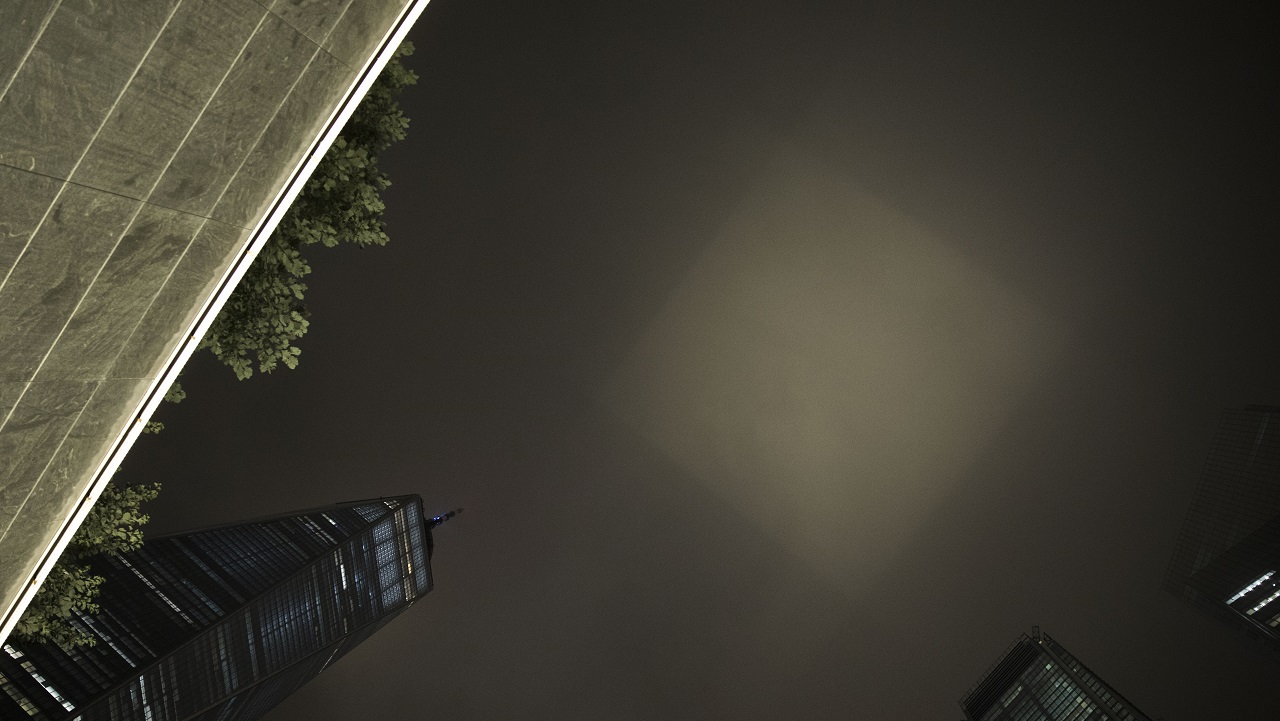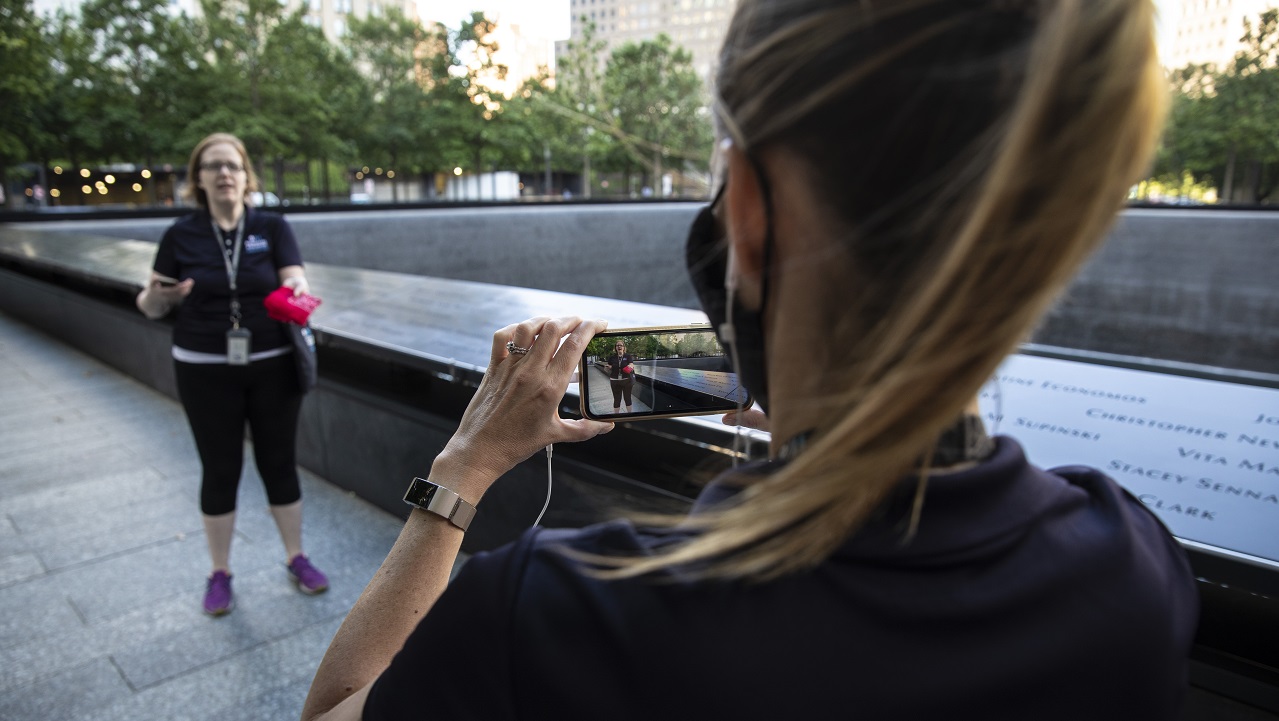Make a donation to the museum
A Tree, Gone; Its Roots, Enduring
A Tree, Gone; Its Roots, Enduring
Valued for their practical roles as shade providers and pollution filters, trees are nature’s mediators in modern, man-manipulated environments such as New York City. At the 9/11 Memorial, the maturing swamp white oaks offer a verdant, summertime canopy over the open-air plaza. As their deciduous leaves mellow to burnished gold in late autumn, they provide a colorful counterpoint to that 8-acre expanse. Their seasonal transformation dramatizes the lifecycle, from spring awakening through winter dormancy.
Most visitors to the Memorial gravitate to “The Survivor Tree,” the outlier Callery pear tree near the South Pool, inspired by its remarkable story of trauma, rescue, and return to the former World Trade Center campus. The Survivor Tree’s demonstration of arboreal vigor takes place above ground. Under the paved surfaces, the vital roots of nearly 400 trees are tended by an unseen irrigation, aeration, and nutrient delivery system.
In the weeks after September 11, sculptor Steve Tobin (b. 1957) seized the idea of commemorating a less fortunate American sycamore tree at the edge of Ground Zero, toppled by the force of the collapsing towers. The resulting artwork is striking not only for its ambitious scale and engineering virtuosity but also because of the tree’s presentation as something other than terrestrial branches, foliage, and woody surfaces.
Instead, Tobin monumentalized the plastic relic of its stump and once-concealed, skeletal roots. The choice provokes questions that seem to transcend the tree’s predicament, inviting reflection on the source of civilization’s endurance and weaknesses; of humankind’s capacity for cooperation and goodwill as well as for inflicting pain and injustices on one another. These deep, entangled queries feel as relevant to the summer of 2020 as they did for the unsettling era of global terrorism launched in 2001.
In September 2005, Tobin’s Trinity Root became one of the first permanent memorials to the events of 9/11 in lower Manhattan with its installation at Trinity Church’s sideyard at the head of Wall Street on Broadway. Ostensibly, the sculpture may seem unusual as a tribute to nearly 3,000 individuals killed that deadly Tuesday. Its aptness, however, arises from the linked story of the tree that inspired Tobin and his studio practice, which specialized in artful castings of natural forms, at epic scale.
The seed for the piece was planted soon after the World Trade Center’s erasure, by a report of the wondrous sparing of nearby St. Paul’s Chapel, a mid–18th century landmark and affiliate of the Episcopalian Trinity Wall Street parish active in New York City since 1697.
In the churchyard behind the venerable chapel stood an at least 70-year-old American sycamore, a species favored for its urban hardiness and gift of shade. On the morning of the attacks, the tree shielded the house of worship from destruction, its branches buffering debris spewed from the towers. Regrettably, the bombardment also dislodged the tree from the earth, exposing its massive root system to the caustic dust generated from the macerated buildings. There was no recourse but to cut up and remove its trunk so that the exterior yard could be cleared, with protection secured for the historic cemetery stones.
The sycamore was but one of countless examples of collateral damage from the attacks. However, many perceived the felled tree as a symbol of heroic sacrifice. Tobin became intrigued with its excavated stump, weighing some 600 pounds. He proposed to fabricate a bronze cast of it, aspiring to create a secular metaphor for the powerful “unseen” which could nurture mankind through crisis, fortifying our resolve to repair and persevere. Tobin’s reading of the root was influenced by the adjacent operations at St. Paul’s Chapel, which had been repurposed into a volunteer-led respite center for Ground Zero’s rescue and recovery workers. Within the sanctuary, “radical hospitality” and selfless empathy were dispensed freely, around the clock, to anyone in need.
Gaining access to the sycamore’s vestiges took time. Three years passed before clearance arrived with the appointment of a new rector at Trinity St. Paul’s Chapel, James H. Cooper, who authorized shipping the stump to Tobin’s studio in Bucks County, PA. The costs, covered in their entirety by the artist, included material and foundry expenses as well as salaries for 10 assistants. (Ultimately, 20,000 hours of labor would be invested in this venture.) To enhance authenticity, Tobin arranged for items entangled in the tree’s exposed roots—fragments of rock, brick and pipe—to be sent to the foundry so that casts of this detritus could be seamed into the main composition, which included multiple individually cast and welded root branches. Special care was even taken to replicate a chainsaw gash visible in the surviving wood, suffered during the sycamore’s 2001 dissection. A startling, deep red hue akin to life-blood was chosen for the finished sculpture’s patina, into which Tobin incorporated actual dust and dirt from the chapel yard. At the project’s conclusion, the tree remains—esteemed by the Rev. Dr. Cooper as an “organic piece of 9/11”—were returned to Trinity Wall Street.
When dedicated on the fourth anniversary of 9/11, the 3-ton ensemble Trinity Root measured 15 feet high by 23 feet wide. Its siting within in the exterior courtyard of Trinity Church several blocks south of St. Paul’s Chapel was dramatic. For a decade thereafter, in that same prominent location, the memorial was photographed by millions of pilgrims to lower Manhattan, and encountered daily by those working or residing in the Financial District. In 2015, a new administration at Trinity Wall Street decided that the mammoth Root had run its course at this address. To the dismay of the artist, who understood the location as permanent and rightful to the sculpture’s genesis, the piece was removed to the grounds of a church-operated retreat center in Connecticut. Litigation ensued.
Tobin’s large-scale working model found a more suitable destiny. In 2016, this arresting maquette was donated to the 9/11 Memorial & Museum by the sculptor, thereby preserving a bronzed fraction of the storied sycamore near its original habitat outside St. Paul’s Chapel. Today, Trinity Root endures, virtually, as an exemplar of Response Art shared in Inside the Collection.
By Jan Seidler Ramirez, Executive Vice President of Collections & Chief Curator, 9/11 Memorial & Museum
Previous Post
Behind the Lens: A Light in the Sky

In this series, 9/11 Memorial & Museum staff photographer Jin S. Lee shares his view of select photographs taken on the site.
Next Post
9/11 Memorial Activities Offered As Part Of NYC Virtual Field Trip Initiative

NYC & Company, the City of New York’s official destination-marketing organization, is launching an “NYC Virtual Field Trips” online resource, which will spotlight online experiences of New York’s many cultural institutions—including the 9/11 Memorial & Museum—to engage those currently unable to visit the city.